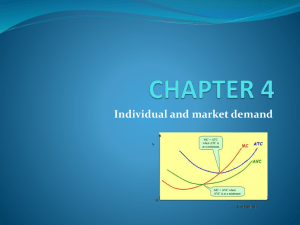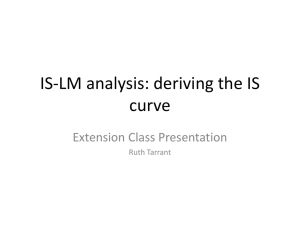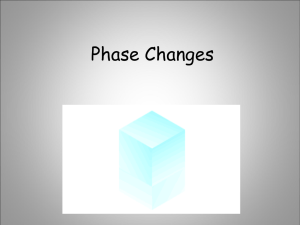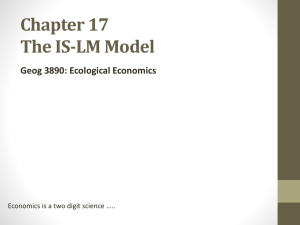the BP Curve
advertisement
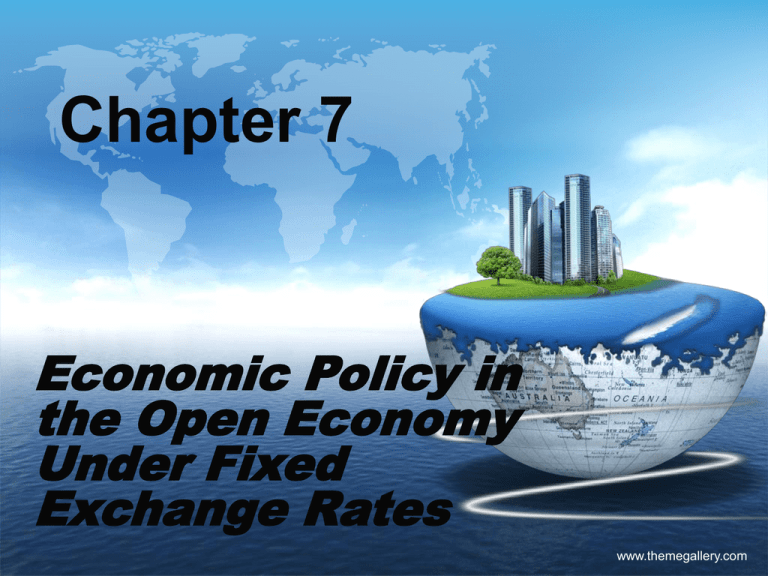
Chapter 7 Economic Policy in the Open Economy Under Fixed Exchange Rates www.themegallery.com Learning Objectives Explain general equilibrium in the macroeconomy using the IS/LM/BP model. Describe the impact of changes in fiscal policy on income, trade, and interest rates under fixed exchange rates. Describe the impact of changes in monetary policy on income, trade, and interest rates under fixed exchange rates. Perceive how varying degrees of capital mobility alter the effectiveness of fiscal and monetary policy under fixed exchange rates. Targets, Instruments, and Policy: A Model “External balance” Any decrease in the interest rate (e.g., because of expansionary monetary policy) will cause a decrease in shortterm capital inflows or an increase in short-term capital outflows and a BOP deficit. Expansionary fiscal policy (by increasing Y and M) also leads to a BOP deficit. “Internal balance” Expansionary monetary policy lowers interest rates and increases I; this will be inflationary unless fiscal policy offsets it. As we discussed in Chapter 24, there are four situations when there are internal and external imbalances: Case I: BOP deficit; unacceptably rapid inflation Case II: BOP surplus; unacceptably high unemployment Case III: BOP deficit; unacceptably high unemployment Case IV: BOP surplus; unacceptably rapid inflation The Mundell-Fleming Diagram i IB IV EB II I III To achieve internal and external balance, fiscal and monetary policy must both be used. G-T General Equilibrium in the Open Economy: the IS/LM/BP Model To understand the effects of policies on the open economy, we need to use a general equilibrium model. The IS/LM/BP model is built around three sorts of equilibria: 1.money market equilibrium (the LM curve), 2.real sector equilibrium (the IS curve), and 3.BOP equilibrium (the BP curve). Money Market Equilibrium: the LM Curve The LM curve comprises all combinations of the interest rate (i) and income (Y) such that money supply and money demand are equal. Money Market Equilibrium: the LM Curve Money supply is assumed to equal money demand. Money supply is fixed. Money demand depends inversely on the interest rate (i) and positively on income (Y). • As interest rates rise, the opportunity cost of holding money rises, and so the quantity demanded of money decreases. • As income rises demand for money increases. Money Market Equilibrium: the LM Curve Ms i At i1, Ms>Md: people will buy bonds, reducing i. At i2, Ms<Md: people will sell bonds, increasing i. i1 ie i2 L = f(i,Y) money Money Market Equilibrium: the LM Curve If income rises, money demand will exceed money supply, and interest rates will rise. Therefore, the LM curve is the positive relationship between the interest rate and income (Y). Points to the left of the LM curve mean there is an excess supply of money; points to the right imply an excess demand. Money Market Equilibrium: the LM Curve i LM income Money Market Equilibrium: the LM Curve Increases in Ms or decreases in Md will shift LM to the right. Decreases in Ms or increases in Md will shift LM to the left. Real Sector Equilibrium: the IS Curve The IS curve comprises all combinations of the interest rate (i) and income (Y) such that the real sector of the economy is in equilibrium. Real Sector Equilibrium: the IS Curve Investment should depend inversely on the interest rate (i). • As interest rates rise, the cost of borrowing rises, so I falls. As before, consumption (C) depends positively on income (Y). Also, exports (X) and government spending (G) are fixed. Real Sector Equilibrium: the IS Curve The IS curve is the relationship between the interest rate and Y. • As the interest rate falls, investment increases, thereby increasing Y. • As the interest rate rises, investment decreases, thereby decreasing Y. Therefore, the IS curve is downward- sloping. Real Sector Equilibrium: the IS Curve i IS income Real Sector Equilibrium: the IS Curve Increases in Decreases in autonomous I, autonomous I, X, G or X, G or decreases in T increases in T will shift IS to will shift IS to the right. the left. BOP Equilibrium: the BP Curve The BP curve comprises all combinations of the interest rate (i) and income (Y) such that the balance of payments is in equilibrium. BOP Equilibrium: the BP Curve The BP curve is the relationship between the interest rate and Y. • If Y increases and i is unchanged, M will increase and a BOP deficit will open. • To return to BOP balance, i must rise. This would trigger net shortterm capital inflows. Therefore, the BP curve is upward- sloping. BOP Equilibrium: the BP Curve i BP income BOP Equilibrium: the BP Curve Points to the Points to the left of the BP right of the BP curve imply a curve imply a BOP surplus. BOP deficit. BOP Equilibrium: the Slope of the BP Curve The slope of the BP curve depends on how responsive short-term private capital flows are to changes in the interest rate. Points to the right of the BP curve represent BOP deficits, triggering an increase in i, which would cause in increase in capital inflows. If capital inflows are very responsive, a small Δi will bring us back to BOP equilibrium (that is, a relatively flat BP curve). BOP Equilibrium: the Slope of the BP Curve The upward-sloping BP represents “imperfect capital mobility.” The typical upward slope of the BP curve results from impediments to capital flows or when the country is large enough to influence international interest rates. BOP Equilibrium: the Slope of the BP Curve Capital could be perfectly mobile. This would occur if any deviation of the domestic i away from the international rate immediately triggered capital flows that brought interest rates back in line. When capital is perfectly mobile, the BP curve is a horizontal line. BOP Equilibrium: the Slope of the BP Curve Capital could be perfectly immobile. If a country fixes its exchange rate, it typically maintains strict foreign exchange controls. When capital is perfectly immobile, the BP curve is a vertical line. BOP Equilibrium: the BP Curve A depreciation of the home currency, an autonomous increase in exports, or an autonomous decrease in imports will shift BP to the right. An appreciation of the home currency, an autonomous decrease in exports, or an autonomous increase in imports will shift BP to the left. Equilibrium in the Open Economy LM i BP E iE Only at point E is the economy in full equilibrium. IS YE income Equilibrium in the Open Economy: Adjustments Suppose exchange rates are fixed. How does the system adjust to a “shock” such as an increase in foreign income? This should increase exports, shifting BP rightwards to BP′. The IS curve will shift rightwards to IS′. To maintain the fixed exchange rate, the central bank must purchase the surplus foreign currency; this shifts LM rightwards to LM′. Eventually, a new equilibrium is reached at E''. Equilibrium in the Open Economy LM i LM' BP BP' i* E E'' i'' IS Y* Y'' IS' income Fiscal Policy Under Fixed Exchange Rates With perfect capital immobility, any fiscal stimulus initially increases Y and M (and also i), but because capital is immobile, a BOP deficit emerges, decreasing the money supply and increasing i further. In the end, Y returns to its original level – the fiscal stimulus completely crowds out domestic investment (I). Fiscal Policy Under Fixed Exchange Rates i LM' BP LM Perfect capital immobility E' i' iE E IS YE IS' income Fiscal Policy Under Fixed Exchange Rates With perfect capital mobility, any fiscal stimulus increases Y and M, but i does not rise due to capital inflows. To maintain the fixed exchange rate, the central bank must increase the domestic money supply. In the end, Y rises, but i stays the same. Fiscal Policy Under Fixed Exchange Rates LM i LM' Perfect capital mobility E' iE E BP IS YE Y' IS' income Fiscal Policy Under Fixed Exchange Rates The bottom line: • When capital is relatively mobile, fiscal policy is more effective at increasing national income. • When capital is relatively immobile, fiscal policy is less effective at increasing national income. Monetary Policy Under Fixed Exchange Rates With perfect capital immobility, a monetary stimulus initially increases Y and M (and lowers i), but because capital is immobile, a BOP deficit emerges. The central bank must sell foreign exchange (decreasing the money supply) to maintain the fixed exchange rate. In the end, the LM curve returns to its original place – the monetary stimulus doesn’t change Y. Monetary Policy Under Fixed Exchange Rates i LM LM' BP Perfect capital immobility iE E IS YE income Monetary Policy Under Fixed Exchange Rates With perfect capital mobility, any monetary stimulus increases Y and M, but i does not fall due to capital inflows. Again, to maintain the fixed exchange rate, the central bank must decrease the domestic money supply. In the end, the LM curve returns to its original place – the monetary stimulus doesn’t change Y. Monetary Policy Under Fixed Exchange Rates LM i LM' Perfect capital mobility iE E BP IS YE income Monetary Policy Under Fixed Exchange Rates The bottom line: • When capital is relatively mobile, monetary policy is ineffective at increasing national income. • When capital is relatively immobile, monetary policy is ineffective at increasing national income. Maintaining a fixed exchange rate system means losing monetary policy as an effective tool. Effects of Official Changes in the Exchange Rate System Obviously, to maintain a fixed exchange rate system, a country would not want to devalue or revalue the currency often. However, such policy actions are occasionally required: what will be the effects? Effects of Official Changes in the Exchange Rate System If the home country’s exchange rate is devalued, exports rise and imports fall. This shifts both the IS and BP curves rightward. The money supply must be expanded – the central bank must buy foreign exchange. This means the LM curve also shifts rightward. The devaluation increases Y. Effects of Official Changes in the Exchange Rate System The bottom line: When capital is relatively immobile, a devaluation increases national income. When capital is relatively mobile, a devaluation increases national income to an even greater extent. Add your company slogan www.themegallery.com


